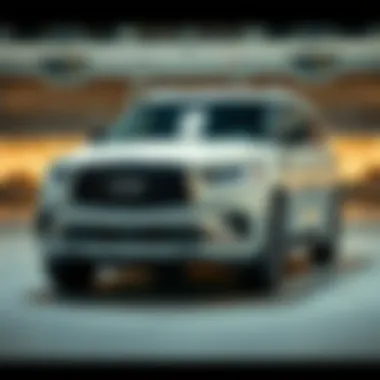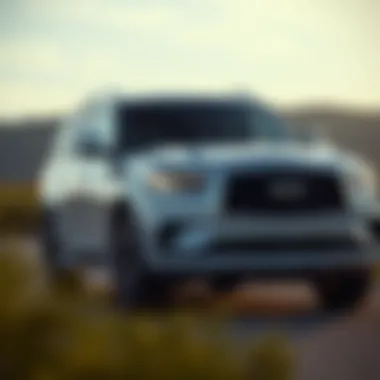Understanding the Total Costs of the Infiniti QX80


Intro
Purchasing a luxury SUV like the Infiniti QX80 requires more than just an initial price consideration. To truly understand its value, prospective buyers need to explore the range of costs involved in owning such a vehicle. This is not just about the MSRP but also about the long-term implications that come with it.
From insurance rates to maintenance expenses, each factor plays a part in the overall financial commitment. This article seeks to break down these costs comprehensively, ensuring buyers are well-equipped to make informed decisions. Understanding the cost landscape around the Infiniti QX80 is integral to maximizing the investment in this high-end automobile.
Market Research Overview
Exploring the costs associated with the Infiniti QX80 begins with looking at the market it operates within. Being a part of the luxury SUV segment, the QX80 faces unique challenges and opportunities that are influenced heavily by industry trends and consumer behavior.
Industry Trends and Insights
As gas prices fluctuate and environmental concerns rise, consumers are increasingly looking for efficiency and eco-friendliness in their vehicles. Still, full-size SUVs like the QX80 retain their allure due to spaciousness and luxury features. Many manufacturers, including Infiniti, are adapting their strategies, focusing on offering advanced technology and sustainability without compromising luxury. The demand varies based on economic conditions, which shapes pricing and consumer expectations.
Consumer Demographics
The Infiniti QX80 typically attracts buyers who prioritize luxury and ample space over fuel economy. The demographic primarily comprises families needing room and affluent buyers who appreciate high-quality craftsmanship. Identifying these groups helps in understanding the pricing structure and overall market positioning of the QX80, as the value perception among potential customers significantly influences their buying decisions.
"In today's automotive market, luxury does not solely equal expensive; it also signals performance, insignia, and technological advancement."
Reviews and Ratings
To evaluate the Infiniti QX80's worth, we need to consider various reviews and ratings. Consumers often lean towards this data for insights on reliability, performance, and features.
Detailed Product Breakdown
The Infiniti QX80 is praised for its lavish interior and innovative technology. It comes equipped with a robust V8 engine, providing substantial towing capacity. However, the fuel economy may create a rift between practicality and luxury. Notable features include:
- Spacious seating for up to eight passengers.
- A user-friendly infotainment system reflecting current technological trends.
- Top-tier safety features that enhance driving confidence.
These elements fall into various cost categories, from expected depreciation to insurance that reflects the vehicle's high market value.
Expert Review Summaries
Experts in the automotive field often commend the QX80 for its comfort and on-road presence. Ratings from sources like Edmunds and Consumer Reports frequently highlight the vehicle's family-friendly characteristics, spaciousness, and safety ratings. Nonetheless, some critiques revolve around its fuel efficiency and relatively higher initial cost compared to competing models. Such feedback can be pivotal in evaluating whether this vehicle aligns with a buyer's needs and financial capacity.
Prelude to the Infiniti QX80 Cost
Purchasing a vehicle like the Infiniti QX80 isn’t simply about selecting a model off the lot; it’s a financial journey that encompasses various considerations. This luxury SUV offers a unique blend of style, comfort, and performance, but understanding its total cost is paramount for any potential buyer. Knowing how the initial price reflects in the broader picture can help one assess whether this vehicle aligns with their budget and lifestyle.
From the Base Price to the additional costs that might sneak up on you, every aspect plays a pivotal role. It's crucial to dive into the intricacies of not just the MSRP, but also the ancillary costs like taxes, fees, and financing options. The understanding gained here can equip buyers with the knowledge they need to avoid pitfalls and make educated decisions.
Understanding the Luxury SUV Market
Luxury SUVs like the Infiniti QX80 don’t just pop out of nowhere; they exist within a broader context of consumer preference and market trends. The luxury SUV segment has seen a seismic shift over the past decade. People have become increasingly attracted to upscale, spacious vehicles that offer both comfort and performance.
The QX80 finds itself in a competitive landscape populated by rivals like the BMW X7 and the Mercedes-Benz GLS. Each of these vehicles has its own unique selling points, and comparing them necessitates a good understanding of what luxury means in the SUV market. Consumers often look for features such as interior craftsmanship, cutting-edge technology, and overall brand prestige when making their choices.
As trends shift toward all-wheel drive and hybrid options, the QX80 remains a traditionalist with its robust architecture. Some may prefer the reliability tied to conventional designs while others might eye more modern alternatives. Thus, analyzing the luxury SUV market enhances comprehension of where the QX80 stands, both in terms of price and value.
Overview of the Infiniti QX80
The Infiniti QX80 delivers more than just a status symbol; it's a mode of transport designed for family adventures and a plush driving experience. With a seating capacity of up to eight people, it’s excellent for larger families or those who enjoy traveling in style. Its interior is akin to a high-end hotel suite, equipped with plush materials and advanced technology to keep every passenger entertained and comfortable.
Performance-wise, the QX80 doesn’t disappoint either. It sports a powerful 5.6-liter V8 engine that not only offers impressive horsepower but also a towing capacity that can help transport boats, trailers, or anything you desire. However, this level of luxury and power does come with its caveats—like fuel efficiency, which isn't its strongest suit. Considering these features allows a potential buyer to gauge the true worth of the Infiniti QX80 against their own expectations and requirements.
"Understanding the costs associated with the Infiniti QX80 goes beyond its sticker price; it delves into what owning such a vehicle truly entails."
In sum, an informed perspective on the Infiniti QX80's costs is essential for buyers keen on making a substantial investment. As we delve deeper into the financial aspects, from the base price to ownership costs, we'll uncover all the details that matter, empowering consumers to navigate their buying experience intelligently.


Base Price of the Infiniti QX80
When diving into the overall costs of owning an Infiniti QX80, understanding its base price is a crucial step. The base price sets the stage for what buyers can anticipate when they consider this luxury SUV. It's not just about the initial figure seen on the price tag—it's about the entire package, which includes brand prestige, available features, and the long-term value that the QX80 promises.
The base price reflects the starting point of the vehicle's overall affordability and represents what most buyers will consider before moving forward in the purchasing journey. More than simply a number, the base price often gauges the perceived value of the vehicle in comparison to others in the luxury SUV market. This price acts as a benchmark that potential buyers can use to weigh the cost-benefit trade-offs of their investment.
Manufacturer's Suggested Retail Price
The Manufacturer's Suggested Retail Price (MSRP) of the Infiniti QX80 is the officially recommended selling price. This number is published by Infiniti and provides buyers with an idea of what to expect when shopping around. As of my last updates, this rate can fluctuate based on market factors, dealership location, and specific trim selections. Generally, potential buyers should keep in mind that the MSRP does not always reflect the final purchase price—there can be room for negotiation.
It's worth noting that while the MSRP serves as a guideline, dealerships might present additional costs, or even discounts, that can influence the actual price paid. Buyers who understand the MSRP could be better positioned to make informed decisions and negotiate effectively. This approach empowers them to recognize if they're getting a fair deal or if they may need to look elsewhere.
Price Variations Across Trim Levels
The Infiniti QX80 is available in several trim levels, each catering to different buyer preferences and budgets. The variation in base prices across these trims is significant and can reshape one's purchasing decision. The trims typically range from the standard version to high-end models loaded with tech features, premium interiors, and advanced safety options.
- Base Trim: The entry-level trim is designed to offer a luxurious experience while remaining accessible. It's packed with essential features that orients the buyer to Infiniti's design philosophy. This model often begins at a lower price point compared to its more equipped siblings.
- Mid-level Trim: This option typically includes added conveniences such as upgraded audio systems, enhanced interior materials, and possibly additional safety features. The price jump here reflects the extra comfort and tech that buyers receive.
- Luxury Trim: At the top of the lineup, the luxury trim represents the pinnacle of opulence. It boasts features such as a richer sound system, premium leather seats, and advanced driver-assistance systems that enhance both comfort and safety. Naturally, the price reflects this premium experience.
Buyers should take into account not only the base price of the trim they’re eyeing but also how the specific features align with their personal needs and budgets. Each variation in price is not just an increase; it represents a shift in the value proposition that could influence long-term satisfaction with the vehicle.
Having a clear understanding of these price differences can help buyers navigate their choices with greater confidence. The value perception tied to each trim level ultimately informs the decision-making process, guiding buyers to a vehicle that fulfills their expectations and lifestyle needs.
Additional Costs Beyond MSRP
When considering the investment in an Infiniti QX80, potential buyers need to look beyond the Manufacturer's Suggested Retail Price (MSRP). Indeed, the allure of luxury comes with a few additional costs that can significantly impact the overall financial commitment. Understanding these costs is imperative; otherwise, unexpected expenses can create quite a dent in your budget.
Sales Tax and Registration Fees
Sales tax is often the uninvited guest at the buying party, lurking in the background, waiting to add to your already considerable financial outlay. Typically, sales tax on vehicles varies significantly depending on the state, soaring anywhere from 2% to over 10%. For example, if the QX80's MSRP is $75,000 and you live in a state with a 7% sales tax, that’s an additional $5,250 right off the bat.
Moreover, registration fees can add further complications. These fees contribute to the vehicle's legitimacy on the road and generally depend on the vehicle's weight, age, and the state of registration. Each state imposes its own structure, and in some cases, these fees can range from a couple hundred to over a thousand dollars. Not accounting for these can lead to unwelcome surprises when it comes time to make that payment.
- Understanding Local Market Conditions: It's key to remember that these costs fluctuate based on local regulations. Make a point to check with your local Department of Motor Vehicles for specifics.
Dealer Fees and Additional Charges
Dealer fees, often disguised under terms like "documentation fees" or "prep fees", are another layer of costs tied to purchasing a QX80. These charges are supposed to cover the dealership's administrative expenses, but they can sometimes feel like a sneaky tacked-on expense that could easily have you raising an eyebrow.
For instance, it’s not unheard of to see these fees ranging anywhere from a few hundred dollars to upward of $1,500. This variation exists not only among different dealerships but also across states, reflecting local market conditions and dealership policies.
Here’s what you should keep in mind regarding dealer fees:
- Negotiate: These fees are often negotiable. Don’t hesitate to inquire and push for reductions or waivers.
- Transparency: Request a complete breakdown of costs. Any reputable dealer will provide this willingly.
"Understanding the total cost of ownership means accounting for every penny, from tax to dealer fees. Ignorance is not bliss in the world of luxury vehicles."
On top of dealer fees, other charges may apply—such as documentation fees, which must be considered. Some dealerships add these costs based not just on actual processing required but also on profit margins. Therefore, a careful examination of the sales contract is crucial to avoid any pitfalls.
In summary, the allure of the Infiniti QX80 extends beyond its luxurious features. A thorough understanding of the additional costs beyond MSRP is not merely prudent; it’s essential for making an informed decision about your purchase.
Financing Options for the Infiniti QX80
Considering the financing options for the Infiniti QX80 is crucial for potential buyers aiming to understand the total cost associated with this luxury SUV. It's not just about digging into the sticker price; understanding how to fund that purchase can unfold new realms of affordability and manageability. Many prospective owners might find themselves asking how much they'll really pay in the long run. Knowing the ins and outs of available options can help navigate these waters seamlessly.
Loan Terms and Interest Rates
When it comes to loans for the Infiniti QX80, you'll typically encounter various terms and interest rates that can vary significantly based on your credit score, loan duration, and lender policies. Now, it’s essential to look at the options with a critical eye:
- Loan Duration: Most lenders offer terms ranging anywhere from 36 to 72 months. A longer loan term might seem appealing due to lower monthly payments, but buyers should be aware that it can lead to paying more in interest over time.
- Interest Rates: These can swing widely based on market conditions and personal creditworthiness. As of late, rates for luxury vehicles like the QX80 may start around 3% for individuals with excellent credit. Pay particular attention, though; a seemingly small increase in the interest rate can substantially affect your overall repayment.
- Down Payments: Some might hold back on larger down payments due to the desire to retain liquidity for other investments or expenses. However, putting more down initially can lead to lower monthly payments and less interest paid overall.


Many prospective buyers often overlook how vital these elements are in determining the structure of their financing. Understanding how terms and interest rates intertwine with personal finances can empower potential owners to make strategic decisions that support their broader financial picture.
Leasing versus Buying
Deciding between leasing and buying the Infiniti QX80 revolves largely around individual lifestyle choices and financial goals. Each avenue offers distinct advantages and drawbacks that can determine the best fit. Here’s a breakdown:
- Leasing:
- Buying:
- Lower Monthly Payments: Leasing usually entails smaller monthly payments compared to financing a purchase.
- Fewer Upfront Costs: Many leases require little: often just the first month's payment and a security deposit.
- Access to Latest Models: With lease terms often being three years, you may drive a new QX80 sooner than if purchasing.
- Ownership: Once the loan is paid, the vehicle is yours to keep or sell, and you can drive as many miles as you wish—no worrying about penalties.
- Customization: Owning your vehicle opens doors for personalizing without any restrictions from a lease.
- Long-term Costs: While the initial financial output may be higher for buying, in the long run, you might save more, as lease payments don't contribute toward ownership.
In the end, the choice between leasing and buying hinges on personal preferences, financial flexibility, and anticipated vehicle usage. Those who drive less may benefit from leasing, while those looking to own long-term might see purchasing as a more viable option.
"The key is to align your financing option with your financial reality. It’s not just about driving an Infiniti; it’s about driving smartly and understanding commitment."
By grasping the particulars of financing options, prospective Infiniti QX80 buyers can better cement their decision and align their budgets. It’s beneficial to crunch the numbers to see what suits personal finance best and avoid any surprise costs down the road.
Ownership Costs of the Infiniti QX80
Understanding the ownership costs of the Infiniti QX80 is critical for potential buyers. The QX80 isn't just an investment; it's a long-term commitment that demands financial consideration beyond the initial purchase price. This section shines a light on various aspects that affect costs over time and helps underscore the additional financial prudence required to maintain such a luxury vehicle.
Insurance Premiums
When it comes to insurance premiums, owning a luxury SUV like the Infiniti QX80 can lead to higher rates compared to regular vehicles. Factors such as the vehicle's price, age, safety features, and the driver's history all come into play here. The QX80 is generally categorized under higher insurance brackets due to its luxury status.
A few pointers to consider about insurance costs include:
- Coverage Types: Many drivers opt for comprehensive coverage to safeguard their investment.
- Area of Residence: If you live in an area with higher crime rates or accident statistics, expect to pay more.
- Driving Habits: Frequent long-distance drives could lead to higher premiums, as the risk of accidents increases.
*
Depreciation of the Infiniti QX80
Understanding the depreciation of the Infiniti QX80 is crucial for potential buyers and owners alike. Unlike your average sedan, luxury SUVs like the QX80 typically experience a rapid decline in value, particularly in the first few years after purchase. This decline can significantly impact the total cost of ownership, making it an essential element to consider in any comprehensive overview of the vehicle's financials.
When evaluating this specific model, recognizing the factors at play behind depreciation rates can help buyers make informed decisions. The cost of ownership extends well beyond initial pricing; taking depreciation into account can provide a clearer view of long-term investment value.
Factors Influencing Depreciation Rates
Several elements play a role in determining how quickly the QX80 loses its value. Here are some pivotal factors:
- Market Demand: The Infiniti QX80's appeal as a luxury SUV can oscillate depending on market trends. If the demand for luxury vehicles wanes, depreciation will usually spike.
- Brand Perception: Infiniti, while respected, may not hold the same brand cachet as some of its competitors like BMW or Mercedes-Benz. This can contribute to a steeper depreciation curve.
- Mileage and Condition: Vehicles with higher mileage or those that have been involved in accidents tend to depreciate at a faster rate. Regular maintenance and keeping the vehicle in good shape can help stave off steep drops in value.
- Technological Obsolescence: As technology advances, features included in newer models can render older ones less desirable, further accelerating depreciation.
Another critical item to keep in mind is the warranty coverage. The Infiniti QX80 comes with a generous warranty, which can temporarily cushion depreciation. But once that period expires, the rapid decline may reemerge.
Resale Value Projections
Now that we understand the factors affecting depreciation, how does this translate into actual resale values? The Infiniti QX80, while a premium choice, often sees considerable depreciation in its early years. Generally, within the first three years, it can lose around 20-30% of its value. This swift initial drop may appear daunting for potential buyers who are looking to maintain vehicle value.
Looking toward resale values a bit further down the line, a well-maintained QX80 can still fetch a respectable price. Reports indicate that after five years, models maintain around 50-60% of their initial value, which isn't bad when considering other luxury SUVs might dip further. This projection emphasizes the QX80's potential for better value retention compared to its direct competitors.
"A luxury vehicle's value is not merely a price tag; it’s a portrait of its desirability in the eyes of buyers in the subsequent market."
In summary, while depreciation may seem like a necessary evil with luxury cars, understanding it can aid in making better long-term decisions. For consumers who plan to hold onto their QX80 for a while, these factors can significantly impact their eventual return on investment, making this analysis a key element in the purchasing process.
Comparative Analysis: Infiniti QX80 vs. Competitors
The automotive landscape is a complex one, especially in the luxury SUV segment where the Infiniti QX80 resides. This section aims to shed light on why understanding the competition is not just valuable but essential for potential QX80 buyers. With a price tag that's typically on the higher end, the QX80 needs to stack up well against other luxury SUVs to justify the investment. When discussing comparative analysis, two primary elements come into focus: the characteristics of similar vehicles and the overall value proposition that the QX80 brings in comparison.


Similar Luxury SUVs on the Market
When you’re eyeing an Infiniti QX80, you may also want to glance around at some formidable contenders. Several luxury SUVs offer similar features, styles, and performance capabilities. Brands like Lexus, Cadillac, and BMW are all synonymous with luxury and they have models that could easily catch your fancy.
- Lexus LX 600: This SUV is a close relative to the QX80, boasting a reliable reputation and a touch of elegance. It appeals to buyers looking for a seamless blend of luxury and capability.
- Cadillac Escalade: Known for its striking presence and spacious interior, the Escalade often comes up in conversations about premium SUVs. It leans towards a more flashy aesthetic rather than subtlety.
- BMW X7: Offering a sportier feel, the X7 promises a dynamic driving experience. It’s designed for those that prefer a blend of luxury and performance.
Regardless of which model you consider, it becomes clear that each contender brings its own unique flavor to the table, presenting potential buyers with a variety of choices.
Value Proposition Against Rival Brands
When it comes to evaluating the value proposition, the Infiniti QX80 must be dissected beyond its exterior glitz and glamour. The key question is, why might one lean toward the QX80 as opposed to these other high-performing vehicles?
First off, if you are someone who prioritizes spaciousness and comfort, the QX80 holds the upper hand with its generous cabin space and plush seating.
- Exceptional Interior Quality: The materials used within the QX80 feels well-thought-out, resonating with an air of sophistication.
- Advanced Technology Features: Offering a suite of tech options, from intuitive infotainment systems to driver-assistance features, the QX80 keeps pace with today’s demands.
- Robust Towing Capabilities: If you lead an active lifestyle, the QX80 excels in robust towing potential, making it practical for those who need to haul gear or vehicles.
- Long-term Value: The depreciation rates and resale values of the QX80 are usually favorable compared to some competitors, especially for buyers looking for second-hand options.
Understanding competitors is like knowing the playing field before making that crucial play. It equips you with insights that are invaluable.
Long-term Investment Perspective
When contemplating the purchase of the Infiniti QX80, it's essential to understand the broader implications of such an investment. A luxury SUV does not merely serve as a mode of transportation; it embodies a lifestyle choice, resonating with the values and aspirations of its owner. The long-term investment perspective takes into account not only the upfront cost but also the ongoing expenses and potential return on investment, ensuring that prospective buyers are fully informed.
Evaluating Total Cost of Ownership
Calculating the total cost of ownership (TCO) goes beyond the initial purchase price. This evaluation includes various aspects like fuel costs, insurance premiums, maintenance, and repairs. For the QX80, here are a few elements to assess:
- Fuel Costs: Given its size and engine, the QX80 isn't the most fuel-efficient vehicle on the market. Monitoring changing fuel prices and understanding the annual mileage will provide insight into long-term fuel expenditures.
- Insurance Premiums: As a luxury SUV, the QX80 attracts higher insurance rates. Getting quotes from several providers before committing can help estimate annual costs effectively. Comparing coverages can also shed light on what’s truly necessary.
- Maintenance and Repairs: Regular maintenance is critical to sustaining the vehicle’s value. Costs can increase significantly as the vehicle ages, especially if parts need to be replaced or if special services are required. Buyers should be aware of the manufacturer’s recommended maintenance schedule to budget appropriately.
One way to illustrate these factors is to view the TCO as a layered cake. Each layer—fuel, insurance, maintenance, and depreciation—contributes to the overall financial commitment involved in owning the QX80.
Key Considerations for Potential Buyers
Before signing on the dotted line for the Infiniti QX80, several key considerations can guide the decision-making process:
- Resale Value: Understanding how much value the vehicle may lose over time is crucial. The QX80 tends to follow a unique depreciation curve compared to competitors, and awareness of these trends may aid in assessing its viability as a long-term purchase.
- Market Trends: The automotive landscape is ever-changing. Keeping an eye on industry trends, including technological advancements and fuel economy regulations, can influence whether an investment in the QX80 remains sound.
- Personal Usage: It’s vital to consider how the QX80 will fit into your lifestyle. Will it primarily be used for family trips, commuting, or off-roading adventures? Understanding your personal needs will clarify if this luxury SUV is the right fit in the long haul.
"In the grand scheme, owning a vehicle like the Infiniti QX80 should be viewed not just as an expense, but as a valuable asset that contributes to your lifestyle over time."
In summation, a long-term investment perspective on the Infiniti QX80 provides potential buyers with a roadmap to navigate through financial commitments and personal expectations.
By carefully evaluating the total cost of ownership and considering pivotal factors specific to the luxury SUV market, individuals can make informed decisions that resonate with both their financial goals and lifestyle aspirations.
Closure
The conclusion serves as the final stop in the journey of understanding the costs linked to the Infiniti QX80. It's not just a moment for wrapping things up; it’s a crucial element that reaffirms the insights gained throughout the article. Understanding these costs ensures that potential buyers can traverse the complexities of luxury vehicle ownership without losing their way.
Summarizing Cost Aspects
The costs associated with the Infiniti QX80 extend far beyond the initial purchase price. Here are the key cost aspects that underscore its ownership:
- Base Price and Trim Levels: Each trim level presents its own value proposition and price. The differences can be significant, depending on the features and luxury amenities one opts for.
- Additional Fees: Owners need to factor in sales taxes, registration fees, and various dealer charges that can add a chunk to the final cost. These often come as a surprise for those not prepared.
- Financing Choices: Whether it's leasing or buying, financing options influence monthly costs in varying degrees, impacting long-term budgeting.
- Ownership Expenditures: Regular costs such as insurance premiums, maintenance, and fuel efficiency play a crucial role in determining the all-in ownership cost. Fuel costs can be particularly hefty given that the Infiniti QX80 has a larger footprint on fuel consumption compared to smaller vehicles.
- Depreciation Rates: The loss in value over time can significantly affect the vehicle’s resale potential, which is paramount when considering long-term financial implications.
Ultimately, a clear understanding of these components can save prospective buyers not just money, but also time and frustration in making the right investment in their luxury SUV.
Final Thoughts on the Infiniti QX80 Value
In wrapping up the nuanced discussion around the Infiniti QX80’s costs, it’s essential to reflect on its overall value. The Infiniti QX80 is not just another luxury SUV; it represents a blend of sophistication, performance, and comfort. However, this status comes with responsibility—financially and otherwise.
Consumers should weigh the impressive features and robust driving experience against the potential expenses of ownership. The vehicle shines in technology, safety, and comfort, making it a solid contender in its class. However, the decision shouldn't be taken lightly.
Before diving into a purchase, it's beneficial to ask:
- What are the long-term needs? How often does one plan to use the vehicle for travel or transporting family?
- What features are essential? These can make a difference in pricing and ownership costs.
- How well does it fit into the budget? Not to forget the recurring costs that come with insurance and maintenance.
In essence, the Infiniti QX80 offers notable luxury and practicality, but prospective buyers must navigate its financial aspects with diligence to ensure it aligns with their lifestyle and budget. It’s never just about the vehicle; it’s about the experience of owning it, as well.







